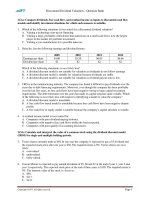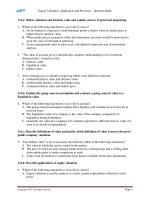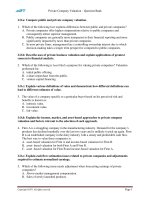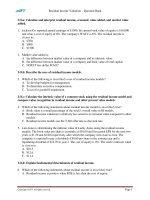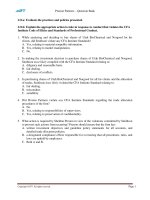CFA 2018 level 2 ethics quest bank changing investment objectives QBank
Bạn đang xem bản rút gọn của tài liệu. Xem và tải ngay bản đầy đủ của tài liệu tại đây (84.59 KB, 3 trang )
Changing Investment Objectives – Question Bank
LO.a: Evaluate the disclosure of investment objectives and basic policies and determine
whether they comply with the CFA Institute Standards of Professional Conduct.
LO.b: Describe appropriate actions needed to ensure adequate disclosure of the investment
process.
1. By marketing the Paine Webber Short-Term US Government Fund as a low volatility
investment, but then deviating from the Fund’s investment objective and investment policy
without seeking clients’ approval, Mitchell Hutchins’ Fund violated the CFA Institute
Standard relating to:
A. suitability.
B. communication with clients and prospective clients.
C. both.
2. Which of the following is correct regarding the CFA Institute Standard relating to
suitability? Members and candidates have a responsibility to:
A. take investment actions and recommendations that are consistent with the stated mandate
and constraints of the portfolio.
B. disclose those factors that are important to their investment analyses, recommendations,
or actions in their communication with clients.
C. disclose to their clients any compensation, or benefit received from or paid to others for
referrals.
3. Which of the following statements is least likely true with respect to communication with
clients and prospective clients? Members and candidates should:
A. disclose the general investment process and security selection used for portfolio
construction and notify clients of any material changes.
B. promptly disclose certain limitations and risks upon clients’ requests.
C. ensure that communication regarding the investment performance is fair, accurate, and
complete.
4. Which of the following least likely relates to Standard III(C) – Suitability and Standard V(B)
Communication with Clients. CFA Institute members are required to:
A. conduct a judicious inquiry into an investor’s financial situation, investment history, and
investment objectives when constructing a portfolio.
B. communicate to clients, the general principles of the investment processes involving
security selection and portfolio construction at the initiation of the relationship and on a
regular basis.
C. refrain from practices that mislead investors by distorting prices or manipulating trading
volume.
5. Which of the following most likely relates to Standard V(B) Communication with Clients.
CFA Institute members are required:
A. to disclose all matters that could impair their independence and objectivity or interfere
with their duties to clients.
Copyright © IFT. All rights reserved.
Page 1
Changing Investment Objectives – Question Bank
B. to disclose to clients, and obtain authorization from them in case changes are made to the
investment objectives or strategies of portfolios.
C. to update client information relating to their financial circumstances and investment
objectives once in two years.
Copyright © IFT. All rights reserved.
Page 2
Changing Investment Objectives – Question Bank
Solutions
1. C is correct. Mitchell Hutchins sold the Fund as a low volatility investment, while it
continued to diverge from its investment objectives by investing in IOs, and POs, without
client knowledge and approval. Thus the Fund violated Standard of III (C) – Suitability, and
Standard V(B) – Communication with Clients and Prospective Clients.
2. A is correct. Section: Standard III(C) – Suitability safeguards the interests of
shareholders/clients of a portfolio/fund by requiring that members manage a portfolio
according to a specific mandate or strategy. This is important for investors as they can
ascertain the suitability of the fund for themselves. Choice B relates to Standard V(B) –
Communication with Clients and Prospective Clients. Choice C relates to Standard VI(C) –
Referral fees.
3. A is correct. The Standard V(B) - Communication with Clients and Prospective Clients
protects investors by providing them with sufficient knowledge about the construction of
portfolios/funds, and the requisite investment process involved. If changes made by a
manager in the investment mandate of a portfolio remain undisclosed then investors are
unable to select investment products and services that are suitable and appropriate for them.
Choice B is incorrect because members and candidates are required to communicate to all
clients, significant limitations and risks of the investment process. Choice C relates to
Standard III (D) – Performance Presentation.
4. C is correct. Choices A and B are steps taken by the CFA Institute members to ensure that
they abide by the principles of suitability and communication to clients. Choice C relates to
Standard II(B) – Market Manipulation.
5. B is correct. If members change the investment objectives or strategies of portfolios, then
clients have to be informed. Full disclosure regarding the effect of the change on the portfolio
should be made and authorization of the change in strategy must be received from clients.
Choice A relates to Standard VI(A) – Disclosure of Conflicts. Choice C relates to Standard
III(C) – Suitability, which specifies that the client information incorporated into an IPS
should be updated at least annually.
Copyright © IFT. All rights reserved.
Page 3
